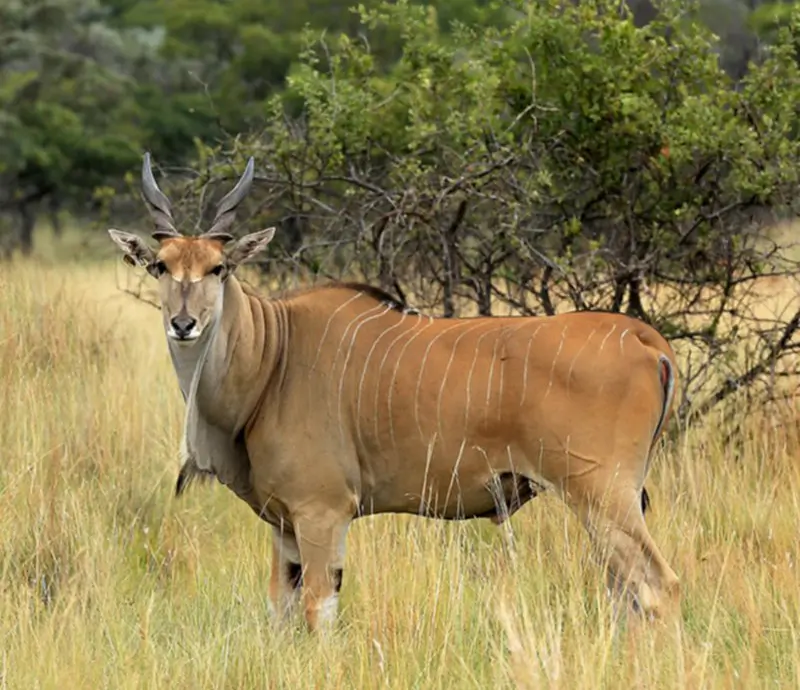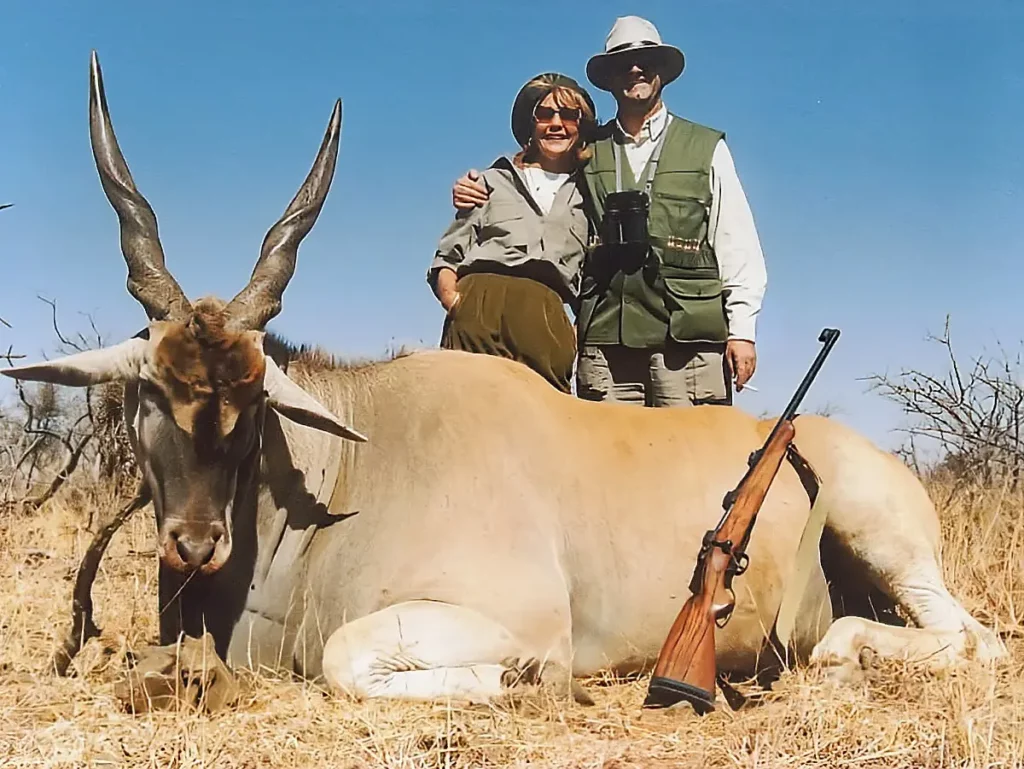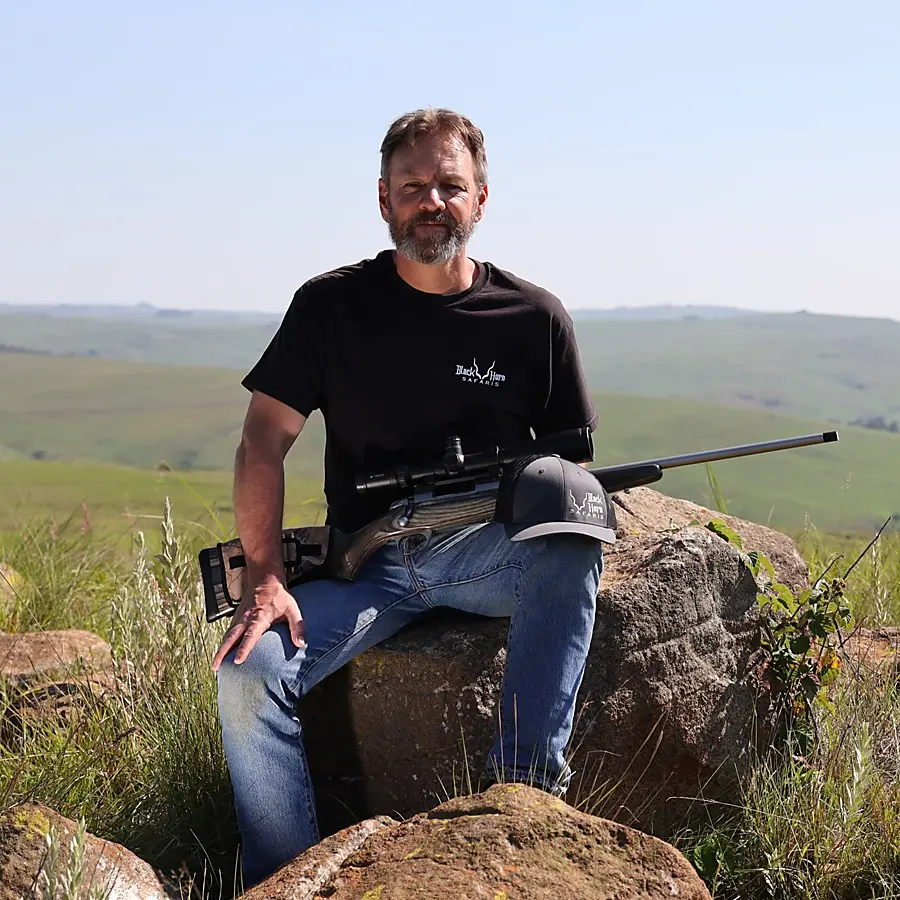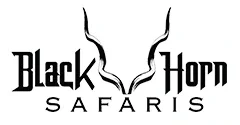Introduction to Cape Eland and Livingstone Eland
Hunting the Cape Eland and Livingstone Eland is an adventure not to be missed. Eland are the largest antelope species in Africa, they present a popular and challenging quarry for hunters across the African continent. These majestic animals are not only sought after for their impressive size, but also for their stunning horns and beautiful skins. In this guide, we will cover everything you need to know to have a successful Eland hunt, including understanding their behavior, choosing the right rifle and optics gear, and Eland hunting costs and packages.
Description and Differences between Cape Eland and Livingstone Eland
The Cape Eland, also known as Taurotragus oryx, is a large, herbivorous antelope that is found in Southern and Eastern Africa.
Livingstone Eland Taurotragus oryx livinstonii also found in the northern most parts of South Africa and South West of Zimbabwe.


Physical Features
Cape Eland and Livingstone Eland are the two largest antelope species, with males weighing up to 1000 kg and standing over six feet tall at the shoulder. Despite their size, Cape Eland is slightly larger and heavier than Livingstone Eland. While both species have shaggy coats, Cape Eland is usually darker in color, ranging from reddish-brown to grayish-brown, while Livingstone Eland has a light brown or yellowish-brown coat. The two species also have distinctive markings. Cape Eland has white vertical stripes on the forehead and darker patches around the knees, while Livingstone Eland has a more uniform coat with no distinct markings. The horns of Cape Eland are thicker and longer than those of the Livingstone Eland, with a characteristic spiral shape.
Both Cape Eland and Livingstone Eland are famous for their huge size, long, spiral horns, and beautiful coat, which make them a popular quarry for visiting safari goers to Africa.
The Physical Characteristics of Cape Eland
The Cape Eland is the largest antelope in the world, weighing up to 1,000 kg (2,200 lb), and standing up to 1.8 m (5 ft 11 in) tall at the shoulder. Both males and females have long, spiral horns that can grow up to (47 in) in length. Their coats are greyish-brown, with a distinctive dark stripe running along the spine and a white patch on the forehead. They have large, pendulous ears that help them detect predators and a dewlap, a flap of skin under their chin that they can inflate during the mating season to impress potential mates.
Brief Description of Livingstone Eland
The Livingstone Eland, scientifically known as Taurotragus oryx livingstonii, is a subspecies of the Cape Eland, one of the largest antelope species found in Africa. Named after the famed explorer David Livingstone, this remarkable animal is predominantly found in the woodland and savannah regions of southern Africa. They are characterized by their robust body, which can reach up to 3 meters in length and 1.6 meters at the shoulder, and weight that can exeed 900 kilograms. Boasting a light to dark brown coat, both sexes have distinctive, spirally twisted horns. As herbivores, their diet is composed of a diverse range of plants, grasses, and leaves. Livingstone Elands exhibit unique social behaviors, typically forming herds of up to 500 members in the wild. They are also renowned for their exceptional endurance and fast galloping trot, despite their large size.
World Record
Rowland Ward records of big game has the world record for Cape Eland as 47 4/8 inches for Cape Eland and 44 2/8 for Livingstone Eland.
Minimum for entry into Safari Club International is 77 and 79 respectively, and R W 35 inches for both species.
Mating Season
The mating season for Eland usually occurs during the rainy season when there is an abundance of food. This timing ensures that the females will have access to ample resources to support their developing offspring.
Best Locations
South Africa: Sportsmen looking for an Eland trophy should consider the Eastern Cape, Limpopo, and North West provinces are known for their high Eland populations and top quality trophies.
Namibia: The central and northern regions of Namibia offer vast hunting areas and good Eland populations.
Zimbabwe: The Matetsi, Bubye Valley, and Save Valley conservancies are prime hunting destinations for Eland.
Botswana: In the Tuli Block and the Kalahari region, hunters can find abundant populations of Cape Eland. These regions provide a unique hunting experience with their diverse landscapes.
Rifles and Calibers for Eland
Eland are very large and tough animals, it is important to use a rifle with enough penetration to ensure a quick, ethical kill. We recommend using a rifle (See rifle hunting) chambered in 30-06 Springfield .300 Winchester Magnum, .338 Winchester Magnum, 9.3 X 62 or .375 H&H Magnum. Minimum bullet weight should be 180 gr or more when hunting Eland.
Optics
A quality rifle scope with 3-9x or 4-12x magnification will provide the versatility needed for varying shot distances. Ensure that your scope is properly mounted and sighted in before you hunt Eland.
Ammunition for Hunting
Premium bonded bullets designed for controlled expansion and deep penetration are essential for hunting Eland. Look for brands such as Nosler Partition, Swift A-Frame, or Barnes TTSX.
Shot placement on an Eland Trophy
When hunting large game like the Eland, proper shot placement is vital, not just to ensure successful hunts, but more importantly, to ensure a quick and humane kill. It is always recommended to aim for the vital organs, which typically means targeting the heart and lungs, located in the chest cavity.
Broadside Shot: This is the most ideal shot for a clean, ethical shot. When the Eland is standing broadside, aim for the middle of the shoulder, approximately one-third of the way up from the bottom of the chest. This should target the heart and lungs, resulting in a quick, humane kill.
Quartering Away Shot: If the Eland is quartering away, aim for the spot that would put the bullet into the vital area from the angle you’re shooting from. This generally means aiming for the bullet to exit on the opposite front shoulder, the goal is to have the bullet pass through the vital organs.
Frontal Shot: A frontal shot can be effective when hunting Eland, but it’s not typically recommended due to the smaller target area and the potential for a poorly placed shot that will wound the animal. If you must take a frontal shot, aim for the center of the chest.
Techniques for Eland Hunts
Here are a few strategies most often used in Southern Africa:
Spot and Stalk Hunting
The spot and stalk method for hunts involves locating Eland from a distance using binoculars, then carefully approaching them while staying concealed. Pay attention to wind direction and terrain features to avoid alerting the animals to your presence.
Ambush Hunting
Another effective technique is ambush hunting, which involves identifying high-traffic areas, such as waterholes or feeding grounds, and setting up a concealed position to wait for Eland to pass by. This hunting technique requires patience and the ability to remain still and quiet for extended periods on the hunt.


Bow Hunting Eland
Bow hunting Eland can be a challenging yet rewarding method, requiring skill, patience, and precision. While hunting with a bow offers a more traditional and intimate approach to hunting, it also demands a higher level of skill and precision to ensure a quick kill.
Understand Eland anatomy: Knowing the location of an Eland’s vital organs is crucial for proper shot placement. Aim for the heart and lung area to maximize the chances of a lethal shot and successful Eland Safari.
Use appropriate bow hunting equipment: Select a high-quality, powerful and efficient bow with a minimum draw weight of 65 pounds. Together with a 5mm arrow and razor-sharp, broad heads for optimal penetration.
Practice for accuracy: Consistent practice is essential for improving your shooting skills and accuracy. Work on your shot placement at various distances and angles to be prepared for different scenarios in the bushveld.
Wait for the right shot: Patience is key in bow hunting. Wait for the Eland to present a broadside or slightly quartering-away shot, which provides the best opportunity to hit the vital organs.
Limit the distance: Bow hunting requires closer proximity to the target than rifle hunting. Aim for a shot within 30-40 yards to maximize accuracy and penetration.
Trophy Cape Eland and Livingstone Eland
Both Rowland Ward and Safari Club international maintain records of the top Cape Eland and Livingstone Eland.
Minimum entry Requirements for Rowland Ward is 35 inches for the longest horn measured along the spiral.
SCI is a minimum score of 77 measure both horns and horn bases and total the score.
Trophy Hunting Packages and Fees
Hunting packages and price for Cape Eland hunting cost $ 5 700.00 including trophy fees, day fees, 7 days hunting and accommodation in a lodge with meals and drinks. This package also includes the services of a Professional Hunter and his team of trackers and skinners.
Hunting package for Livingstone Eland cost $ 6 600.00 including the trophy fee, and 7 days hunting. Also included is accommodation in a safari lodge with meals and drinks, the services of a professional hunter, tracker and skinner for the field preparation of your trophy.
Conclusion
In conclusion, Cape Eland and Livingstone Eland are two distinct antelope species with unique physical features, habitat preferences, behavior, and diet. Hunting these two large Antelope species is the pinnacle of achievement for the avid Safari hunter and epic hunt not to be missed.
References
- Eland Hunting Rituals among Northern and Southern San Groups Striking Similarities: https://www.researchgate.net/profile/David-Lewis-Williams/publication/237829767_Eland_Hunting_Rituals_among_Northern_and_Southern_San_Groups_Striking_Similarities/links/59de1866aca272204c2c7be0/Eland-Hunting-Rituals-among-Northern-and-Southern-San-Groups-Striking-Similarities.pdf
- Signs of the wild Author Clive Walker. Publisher Sable Publishers, P.O. Box 98014, Sloane Park, South Africa
- Wikipedia – Eland: https://en.wikipedia.org/wiki/Eland
FAQs About Eland
What does it cost to hunt Eland?
The trophy fee cost to hunt Cape Eland is $ 3 250.00 and Livingstone Eland $ 4 150.00
What is considered a Trophy Eland?
An Eland bull is considered a trophy when it is fully matured with deep heavy dewlap and dark tuft of hair growing on its forehead. A trophy Eland has a horn length anything over 33 inches.
How much does a typical hunting package for Cape Eland cost?
A typical hunting package for Eland including trophy fees, 7 days hunting and accommodation in a lodge with meals and drinks, the services of a professional hunter, trackers and skinners costs $ 5 500.00.
What are the main differences between Cape Eland and Livingstone Eland?
The main differences between Cape Eland and Livingstone Eland are:
Coloration – Cape Eland lighter grey brown to red brown. Livingstone Eland light brown to slightly yellowish brown and has more visible white stripes.
Shoulder height – Cape Eland 1.8 m Livingstone Eland 1.6 m.
Horns – Cape Eland have thicker horn bases and longer horns.
What rifle caliber is recommended for Cape Eland hunting in South Africa?
A rifle chambered in 30-06 Springfield .300 Winchester Magnum, .338 Winchester Magnum, 9.3 X 62 or .375 H&H Magnum are ideal for Eland hunts. The minimum recommended bullet weight should be 180 gr or more.

Adrian Anderson first obtained his Professional Hunters license in 1991. He is a Big Five and Dangerous Game licensed Professional Hunter and Hunting Outfitter. He has a tremendous love for wildlife and the African bush and enjoys sharing his knowledge with the hunting clients that he guides. Guiding hunters in Africa’s wild places is a passion and seeing them succeed with their goals brings satisfaction. With knowledge of the Safari industry built up over 32 years he is well qualified to give guidance to his hunting clients.
